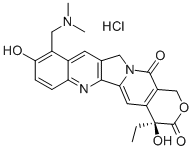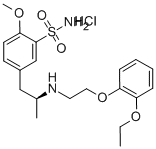racTamsulosinHydrochloride
Synonym(s):
(−)-(R)-5-[2-[[2-(o-ethoxy phenoxy)ethyl]amino]propyl]-2-methoxy benzene sulfonamide, monohydrochloride;5-[(2R)-2-[[2-(2-Ethoxyphenoxy)ethyl]amino]propyl]-2-methoxybenzenesulfonamide hydrochloride;TAM;Tamsulosin hydrochloride
CAS NO.:
Empirical Formula: C20H29ClN2O5S
Molecular Weight: 444.97
MDL number: MFCD00922997
EINECS: 629-756-5
| Pack Size | Price | Stock | Quantity |
| 2.5mg | RMB1624.80 | In Stock |
|
| others | Enquire |
PRODUCT Properties
| Melting point: | 228-230°C |
| alpha | D24 -4.0° (c = 0.35 in methanol) |
| RTECS | DB2430000 |
| storage temp. | 2-8°C |
| solubility | DMSO: >10mg/mL |
| form | white powder |
| color | White to Off-White |
| Merck | 14,9049 |
| InChIKey | ZZIZZTHXZRDOFM-XFULWGLBSA-N |
| SMILES | C1(S(=O)(=O)N)=CC(=CC=C1OC)C[C@@H](C)NCCOC1C=CC=CC=1OCC.Cl |&1:13,r| |
| CAS DataBase Reference | 106463-17-6(CAS DataBase Reference) |
Description and Uses
Tamsulosin is a potent antagonist of α1-adrenergic receptors (α1-ARs; Ki = 0.229 nM in a radioligand binding assay). It is 3,800-fold selective for α1-ARs over α2-ARs (Ki = 871 nM). Tamsulosin antagonizes norepinephrine-induced contraction of isolated rabbit aorta (pA2 = 10.11) but has no effect on contraction stimulated by histamine, serotonin , angiotensin II , or prostaglandin F2α . In vivo, tamsulosin reverses the pressor effect of phenylephrine (Item Nos. 17205 | 18619) in pithed rats. It reversibly reduces fertility in male rats when administered at a dose of 0.15 mg/kg. Tamsulosin (1-100 μg/kg) also reduces prostatic pressure in a dose-dependent manner with minimal hypotensive effects in anesthetized dogs. Formulations containing tamsulosin have been used for the treatment of benign prostatic hyperplasia.
An α1-adrenoceptor antagonist
Safety
| Symbol(GHS) |  GHS07 |
| Signal word | Warning |
| Hazard statements | H302 |
| Precautionary statements | P264-P270-P301+P312-P501 |
| Hazard Codes | Xn |
| Risk Statements | 22-36/37/38 |
| Safety Statements | 26 |
| WGK Germany | 3 |
| HS Code | 29350090 |





